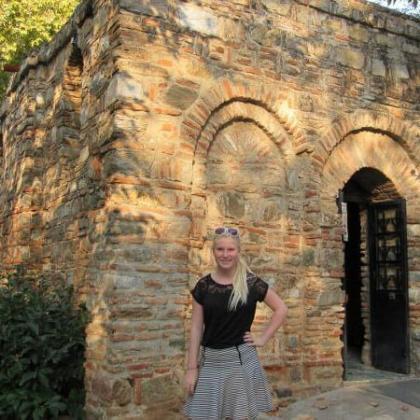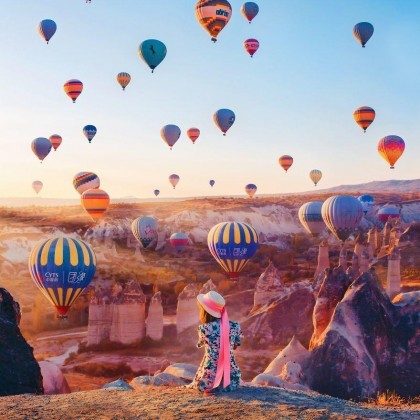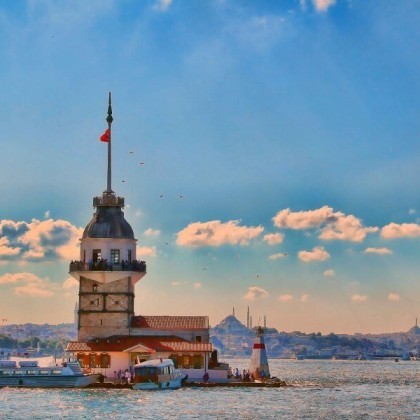Hemsin Valleys
Moving east and inland from Rize, the Kaçkar mountains become steeper and more lush, and their inhabitants become distinctly Hemşinli . The physical characteristics of the valleys as are unique as the cultures they contain: a shocking diversity of flora and fauna in the steaming forests of the lower valleys gives way to the misty moors of the upper grasslands. To move up or down the valley is to follow the seasonality of traditional Hemşin life: from the winter villages at the base to the spring yaylas of the foothills and the summer yaylas in the alpine meadows of the Kaçkars themselves. At every altitude, steeply-pitched stone bridges cross the valleys, and locals and their visiting relatives do then- best to make travelers feel at home, pointing them in the right direction for anything from short walks through the hazelnut trees to longer treks over some of the most striking peaks in the Kaçkar Dağları. Plentiful rainfall characterizes this region, so bring waterproof gear and sturdy footwear. Stinging nettle undergrowth necessitates long trousers and sleeves (see Trekking in the Kaçkars)
Istanbul New Year’s Eve Party Cruise on the Bosphorus
IstanbulWith this new year's eve party program in Istanbul, you will have an amazing new year party on the Bosphorus. Book it now and don't miss the special price!
View Tour3 Days Ephesus, Pergamon and Pamukkale Tour Package
Ephesus, Pamukkale, PergamonIf you want to make an amazing trip to the Ephesus, Pergamon, and Pamukkale, you should read our tour itinerary.
View TourIstanbul and Cappadocia Tour – 7 Days
Istanbul, Cappadocia, TurkeyIf you want to make a trip to Istanbul and Cappadocia both, we strongly suggest you join this amazing package tour. This tour covers all the accommodations, transportations, lunches...
View TourBest of Turkey Package Tour – 8 Days
Istanbul, Cappadocia, Ephesus, PamukkaleAre you looking for a good traveling package in Turkey? With our 8-days Turkey tour, you will make a trip to every important sight in Turkey. Enquire now for...
View TourTwo roads reach the area. From the coastal town of Pazar, it’s 17 km inland to Hemşin itself, a scenic town ill-prepared for tourists. Instead, take the second road 5km east of Pazar and follow a raging river 21km up to Çamlihemşin. Here, the left Though the largest town in the Hemşin area and an important ways on for travelers coming to and from the valleys, Çamlihemşin is an eyesore on and otherwise beautiful curve in the Fırtına River. There are no hotels in Çamlihemşin, but it is home to the only pharmacies and banks in Hemşin territory, with a small hospital (emergency 155) on the premises. The large PIT is across the bridge. (Open M- F 8:30am-5:30pm.)
AYDER
Twenty kilometers up the left-hand fork at Hemşin, the road rises to Ayder, a Hemşin summer village with big ambitions. The ornately-carved blonde wood houses of this mist shrouded village are surrounded by lush forests, open yayla, and, increasingly, the concrete totems of the tourist trade. On the far side of the valley, a slender brook fed by melting mountain snow rushes over crags in a series of cascades to join a roaring stream on the valley floor below.
During high season, bus loads of tourists make the trip to breathe fresh mountain ah and dip into piping-hot spring water. This influx can mean crowds (especially on weekends), but it also makes Ayder a prime spot for watching Hemşinli.
The origins of the Hemşinli people are heavily disputed, but it seems most likely that they are descended from an Armenian tribe that immigrated to the Kaşkar Mountains some 500 years ago, living in virtual isolation for 300 years. Although nominally and linguistically Turkish, the Hemşinli still maintain an independent and unique culture. The best-known markers of Hemginli culture are the colorful dress of the women and the beauty of their breathtaking yayla, the summer villages that rest above the tree-line.
When it’s not yayla season, traditional Hemşinli live with many people in large homes, relying on cow husbandry and corn cultivation for their livelihoods. During Ottoman rule, the Hemşinli lived in peace, sharing the Kaşkar region with Armenians and Greeks, and absorbing elements of Islam into their lifestyle, albeit a somewhat looser Islam that still allows for some occasional drinking, dancing, and ail-out shenanigans. Hemşinli traditionally live on a yearly cycle that follows the seasons. Their winter villages are usually built low in the hills with access to a river, and, as the weather gets warmer, they relocate to higher and higher grass-covered yaylas. The traditional house structure (konak) is divided into three levels made of stone or wood. The basement level is for animals, the second level for family living, and the top level for drying grass.
Out of economic necessity, Hemşinli families have begun a slow urban migration. Today, many villages are primarily comprised of elderly people, and many of the palatial hillside konak are all but empty. The city-dwelling Hemşinli have made a name for themselves all over Turkey as bakers, sweet-shop owners, and master chefs. The diaspora generally returns in full festive force each summer to enjoy the clean air of the yayla and to reestablish familial and cultural bonds. Some Hemşinli predict that there will be an increase in the number of people returning permanently to the villages, but that remains to be seen.
festivities unfold as urban exiles return home. The party kicks off the last weekend in May, and reaches fever pitch with the dancing and mingling of the Ayder Festival. In late June and early July, bring a good raincoat and selective vision. Unbridled development has overtaxed Ayder’s resources, and the town, empty nine months out of the year, can barely cope with the summer influx.
TRANSPORTATION AND PRACTICAL INFORMATION
Ayder consists of two sections: Birinci Ayder (Lower Ayder) and İkinci Ayder (Upper Ayder). Dolmuş stop in the former, home of most of the tourist spots, including hotels, restaurants, hot springs, stores, and the tiny PTT. İkinci Ayder, 500m uphill, has some new hotels, many summer villas, and cow pastures. Dolmuş between Ayder and Çamlihemşin ($1) are frequent in summer, but irregular in winter. Ayder charges a $2 admission fee for private vehicles, which is collected in a booth 4km from the center of town, Ayder has a famous hot-springy hamam but no banks, pharmacies, or hospital services. For any of the latter, visitors must journey down the valley to nearby Çamlihemşin. At the center of town, is a small PTT operating out of the back of a van. Open daily 8:30am-6pm.
ACCOMMODATIONS
Because of their proximity to the hot springs, few hotels have shower facilities. Most average about $10, but you may get a break early in the season, prices often haven’t been adjusted for inflation. Reservations may be necessary during peak season, especially weekends, and some hotels may not open until the end of June. All offer spectacular views, Otel Yesilvadi is the all-around best deal for travelers, with balconies, a fully-equipped kitchen, and an engaging staff. (657 20 50. $4 per person; $7 with shower.) Down the hill from the Yesilvadi, trekking guide Adnan Pirikoğlu runs the Pirikoğlu Pansiyon with doubles and shared showers. (657 20 21. Laundry $3 for up to 6 kg; $3 per person, $8 with dinner.)
A bit farther uphill one can find lodging in more traditional wooden buildings. Çağlayan Hotel (657 20 73) is a few steps up the hill from lower Ayder and one step up from time asceticism. Its owner (the great-grandson of the founder) combines an English-speaking welcome with Hemşinli authenticity. (Singles $7; doubles $14.) A slightly more upscale country-lodge experience can be found at the Hotel Saray , toward the lower end of lower Ayder, which occasionally hosts late- night fetes in its dining room. ( 657 20 01, fax: 657 20 02.15 bathless doubles $15.) Between lower and upper Ayder is a popular public campground/picnic site on the river called the Hoşdere . (Treehouses with 4 beds and bath $20.)
The rustic and airy Kardelen Pansiyon is secluded 2km up the road from lower Ayder, just above Hoşdere, in the cluster of buildings above the Ayder yayla. Muhammet Önçırak leaves his Istanbul home every June to run this peaceful 5-room pension that many travelers use as a base for their treks (see Trekking in the Kaçkars). Before climbing into the Kaçkars, consult the military-issue map hanging on his wall. (657 21 07. Open June-Aug. $5 per person.) Nature lovers and those strapped for cash can camp for free in the area around his house.
FOOD
Ayder is a good place to tie the Hemşinli mountain specialty muhlama, a melted mix of cheese, butter, and corn flour that looks like mashed potatoes and behaves like fondue. Fresh bread replaces a spoon. Dört Mevsim (“The Four Seasons”), between Birinci Ayder and İkinci Ayder, makes it especially wrell ($3). Beer, cognac, and rakı, among others, are also available. Open 8am-midnight. Pirikoğlu Lokantası serves equally wholesome meals. The owner, Adnan Pirikoğlu, is a guide who leads mountain groups (see p. 468) while his brother cooks the local specialty katneraç (soup made of corn flour, milk, and butter; $2). (657 20 21. Open daily May-Oct, 6am-11pm. Full meals cost about $5.)
A late dinner at Nazlı Çiçek Just before the bridge above lower Ayder, provides the best opportunity to see traditional local dancing (apart from August weekends on the yayla). (657 21 30. Fiil meals $3; breakfast $2. Open until 1am.) Next door, the Çise Cafe (657 21 71) stays open until 2 am, and has a cozy fireplace den with full bar and local puddings like laz boregi. Next to the picnic sites at the Hoşdere, a few locals sell grilled trout ($2.50) freshly fished from the river.
SIGHTS
Ayder’s local hamam, below the road by the bridge, is a government-funded natural hot spring housed in the largest and most sophisticated edifice in town. Men (see The Hamam) might want to wear their own shorts rather than the mil¬dewed pairs provided ($.50). Women can wear bathing suits or a large shirt. Either way, locals will engage you in frank conversation, rarely enjoyed beyond the hamam walls. Water temperatures are close to scalding, but a gradual immersion is rewarding (and safe). The time limit is one hour. Locals swear by the curative properties of the hot water and suggest that swallowing it in large doses resolves all stomach problems those wary of dysentery and giardia would be wise to decline. (Apr.-Oct. 15 daily 7am-7pm. Regular bath $3, private tub $7.50.) The strongest draw of Ayder, of course, is the serenity of the surrounding yay¬las and the beckoning slopes of the Kaçkars. Minibuses also ran past İkinci Ayder to the Laz yayla of Avusor (15km, $1), and the Hemşinli Lower Kavron (7km, $2), and Upper Kavron (12km, $2). Avusor is an important stop along the northern trans Kaçkar route to Barhal, while the two Kavrons are popular trekking bases on the shoulder of 3932m Kaçkar Daği. Only Upper Kavron has facilities, a workers’ cottage and diner; otherwise, bring your own. Unless it is a particularly clear day in Ayder, you should expect mists and cool fog, although the warm hospitality and tea unerringly provided by the yayla inhabitants helps to take the edge off of the cold and wet. Some travelers prefer to day trek or hitchhike along these routes.





